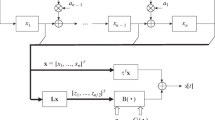Abstract
An original technique is proposed for formation of pseudorandom sequences on the basis of coding methods. The synthesis of large ensembles of signals with improved autocorrelation properties is theoretically substantiated. Methods of correlation analysis are used to study auto-and crosscorrelation properties of sequences being formed.
Similar content being viewed by others
References
M. V. Gryanik and V. I. Frolov, “CDMA technology is the thing of the future of cellular systems in Ukraine,” Mir Svyazi, No. 3, 40–43 (1998).
B. Sklar, Digital Communications: Fundamentals and Applications [Russian translation], Williams, Moscow (2003).
Yu. V. Stasev, I. D. Gorbenko, B. I. Makarenko, A. V. Ivashkin, and D. N. Voronov, “Using compound signals in command-telemetric radiolines,” Kosmichna Nauka i Tekhnologiya, 3, Nos. 5/6, 104–108 (1997).
M. B. Sverdlik, Optimal Discrete Signals [in Russian], Sov. Radio, Moscow (1975).
L. E. Varakin, Communication Systems with Noise-Like Signals [in Russian], Sov. Radio, Moscow (1985).
N. G. Dyadyunov and A. I. Senin, Orthogonal and Quasiorthogonal Signals [in Russian], Svyaz’, Moscow (1977).
D. Ye. Vakmai and R. M. Sedletskii, Questions of Synthesis of Radar Signals [in Russian], Sov. Radio, Moscow (1973).
I. D. Gorbenko, Yu. V. Stasev, and A. A. Zamula, Theory of Discrete Signals: Orthogonal Signals [in Russian], MO SSSR, Moscow (1988).
Yu. V. Stasev and Ye. A. Brydnya, “Derived orthogonal signal systems,” Zb. Nauk. Prats Instit. Problem Modeluvannya v Eneregetitse im. G. Pukhova, No. 25, 230–237 (2004).
Yu. V. Stasev, “A method of processing signals with a minimum phase shift,” Weapon Systems and Defense Technology, No. 1 (1), 79–85 (2005).
E. R. Berlekamp, Algebraic Coding Theory [Russian translation], Mir, Moscow (1971).
R. E. Blahut, Theory and Practice of Error Control Codes [Russian translation], Mir, Moscow (1986).
W. W. Peterson and E. J. Weldon, Jr., Error-Correcting Codes [Russian translation], Mir, Moscow (1976).
F. J. MacWilliams and N. J. A. Sloane. The Theory of Error-Correcting Codes [Russian translation], Svyaz’, Moscow (1979).
Author information
Authors and Affiliations
Additional information
__________
Translated from Kibernetika i Sistemnyi Analiz, No. 1, pp. 3–16, January–February 2007.
Rights and permissions
About this article
Cite this article
Stasev, Y.V., Kuznetsov, A.A. & Nosik, A.M. Formation of pseudorandom sequences with improved autocorrelation properties. Cybern Syst Anal 43, 1–11 (2007). https://doi.org/10.1007/s10559-007-0021-2
Received:
Issue Date:
DOI: https://doi.org/10.1007/s10559-007-0021-2




